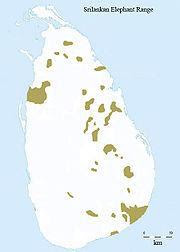Scientific Classification
Kingdom : Animalia
Phylum : Chordata
Class : Mammalia
Order : Proboscidea
Family : Elephantidae
Genus : Elephas
Species : E. maximus
Subspecies: E. m. maximus
Trinomial Name
Elephas maximus maximus

The Sri Lankan Elephant (Elephas maximus maximus), originally from India, is the nominate subspecies of the Asian Elephant and is the largest of the subspecies although smaller than the two species of African elephants.

The elephant population in the National Parks of Sri Lanka is somewhat diminutive in stature when compared both with historical accounts dating back to 200 BC and with the early photographs taken in 19th century during the time of colonial British rule of the island. The smaller size could possibly be the end result of a long-continued process of removing the physically best specimens from the potential breeding-stock through hunting or domestication. Since Sri Lanka was at one time a part of peninsular India (there is evidence that there existed a land bridge between the northern part of the island and the subcontinent many thousand years ago), it is highly likely that the Asian Elephant, roaming South India at the time, "conquered" Sri Lanka literally on foot.
The Sri Lankan Elephant population is now largely restricted to a few National Parks and Nature Reserves. Udawalawe National Park, Yala National Park, Wilpattu National Park and Minneriya National Park are prime locations for spotting elephants.
Food and habitat
The Sri Lankan Elephant is an herbivore. It eats grasses, leaves, bark, fallen fruits (such as wood apple) and palm leaves (like coconut leaf). Kitulpalm Tree is a favorite food. Large bulls need nearly 200 kg of food per day.
The historical range of the Sri Lankan Elephant includes all Sri Lankan eco-regions: lowland rainforests, montane forest and the Sri Lankan dry-zone forest (Habarana). Today the Sri Lankan Elephant is extinct from montane forest and occupies mainly dry-zone forests, although a small population lives in rainforests.

Their average height (height is measured to the shoulder) goes to about 8 feet (2.5m) and 1800 Kg in weight and consume about 200 kg of foliage and grass per day and plenty of water for drinking and bathing. Female elephants give a birth once in 4 years and 2-3 babies in their life span. get 4 sets of teeth and every 10 years a new set of teeth is coming to get the last set when they are about 40 years old. walk about 20 miles per day and young female elephants are reedy for mating when they are 13 years old. very active in the night and most of them sleep under large trees in the day time. only a few tuskers can be seen in Sri Lanka due to brutal killings to get their tusks due to high value. However new laws has introduced to protect them and let tomorrow's people too see them. Some people believe that they have grave yards and come near to a water resource when they are about to die…some do not believe it and say ..when they are old their teeth are wasted and difficulty of consuming heavy branches of trees made them come to a place where there is grass and water.
( See Elephants News...)

The Sri Lankan Elephant is endangered. Ivory trade in Sri Lanka had a very long history for more than 2000 years. In 1800s and early 1900s many bull elephants were killed by tropy-hunting. Between 1999-end of 2006 every year nearly 100 Wild Elephants were killed. Today few elephants live outside protected areas. Tusk elephants are very rare to see in wild due to heavy poaching. Only 5%-7% of wild elephants have tusks. Very low numbers of elephants live in Peak Wilderness sanctuary. The forest covers about 220 square km of lowland and montane rainforest. This is likely the only wild elephant population that lives in the rainforest. Historically large numbers of elephants lived in the rainforest.
| Year | Wild Elephant numbers |
| 1800 | 12000-14000 |
| 1900 | 10000-12000 |
| 1920 | 7000-8000 |
| 1970 | 5000 |
| 1999 | 4000 |
| 2003 | 3500 |
| 2004 | 3350 |
| 2006 | 3150 |
| 2007 | 2900-3000 |
Threats
The main threat is the killing of elephants to protect crops and houses. Others are poaching, deforestion, drought and starvation. During drought seasons many elephants damage agricultural land for food. Nearly 80 elephants were killed in north western Sri Lanka, 50 in south and east and another 30 in other parts of the country, totaling 160 elephant deaths in 2006 alone.
( See FREE Elephant Videos.. and Elephant News)
Conservation
Many national parks and nature reserves are created to conserve Sri Lankan wildlife
Main national parks and reserves that contain viable Sri Lankan elephant populations.
| Conservation land | Area (km²) |
| Yala (Nature reserve, National Park, Yala East) | Total 1508 |
| Wilpattu national Park | 1310 |
| Maduru Oya National Park | 588 |
| 308 | |
| Wasgamuwa National Park | 369 |
| Peak Wildness sanituary | 223 |
| Gal Oya National Park | 260 |
| Floodplains National Park | 173 |
| Padaviya Sanctuary | 65 |
| Minneriya-Giritale Sanctuary | 75 |
| Bundala National Park | 62 |
| Gal-Oya East | 124 |
| Gal-Oya South East | 152 |
See FREE Videos of Sri Lankan Elephants or MORE Elephants......






No comments:
Post a Comment